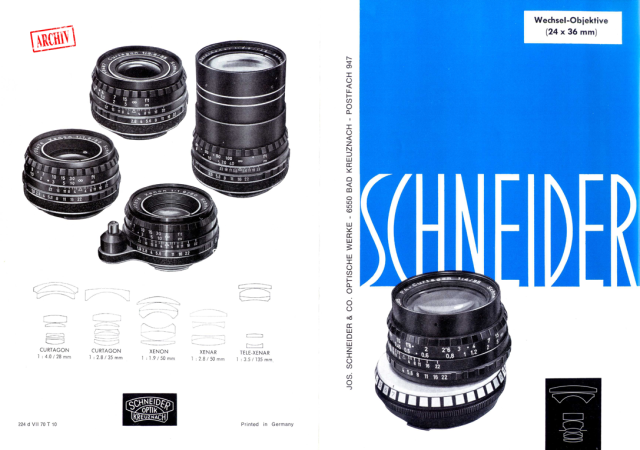Joseph Schneider (1855-1933) founded Optische Anstalt Jos. Schneider & Co in Bad Kreuznach on January 18, 1913, and in 1922 changed its name to Jos. Schneider & Co., Optische Werke, Kreuznach. The chief designer was Albrecht Wilhelm Tronnier (1902-1982), who joined the company in 1924, and would eventually set up the sister company ISCO (throughout his life he accumulated 124 German patents). They produced a large series of lenses with early trademarks such as “Symmar”, “Componar” and “Isconar”, and “Xenar”. From 1919 they produced a Tessar clone, the “Xenar” in focal lengths from 75 to 480mm. In 1925 the famous “Xenon” was introduced, with focal lengths up to 80mm. The Xenon, is perhaps the company’s most famous lens, and is still being made today.

In 1933 with the passing of Joseph Schneider, his son Josef August Schneider took over the company. In 1936 ISCO was formed as an offshoot of the company. Schneider was one of the lens suppliers to the first Exakta, the 4.5×6cm VP Exakta, providing the Xenar f/3.5, the Xenar f/2.9, and the Xenon f/2. The same lenses would find their way onto the first 35mm SLR, the Kine Exakta in 1936.
During WW2, Schneider had to supply the German Wehrmacht and was forced to manufacture Zeiss products. In the 1950s the company continued development of interchangeable SLR lenses, and supplied lenses to almost all German camera manufacturers. Lenses were made in mounts for Edixa-Mat, Pentax (M42), Praktica, Exakta, and Praktina. Lenses for film cameras were also produced, especially for the 8 and 16 mm narrow film cameras that were popular at the time. Also in the 1950s, the company was one of the first to use computers, the Zuse Z22 to perform lens calculations.

Schneider started developing zoom lenses from 1957, which led to the market launch of the Variogon 1:4/80-240 in 1964. At the end of 1967, Schneider introduced its first TV lens, the TV1 Variogon 2.1/18-200mm. NASA used Schneider lenses on its “Lunar Orbiter” space missions of the Apollo program from 1959 to 1976 and on the space shuttle flights since 1990. The first images of the Earth were taken using Schneider lenses with 45 and 75 mm focal lengths. The lunar orbiter probes also each had a Schneider “Xenotar” on board.
Due to changing economies, Schneider ran into economic difficulties and filed for bankruptcy in 1982. The company was subsequently re-founded by Heinrich Manderman and over the years, acquired the B+W filter factory and Rollei photo technology, among others. After German reunification, Manderman also became involved with Pentacon in Dresden and resumed production of the Exakta 66. The company still exists today, producing cinematic lenses and filters, industrial optical filters, industrial lenses (e.g. C-mount), and photo optics, most notably the B+W Filter brand.
Further reading:
- A History of the Xenon Lens – Cheyenne Morrison, Casual Photophile (March 2019)
- Schneider Kreuznach lenses for Exakta – PhotobutMore